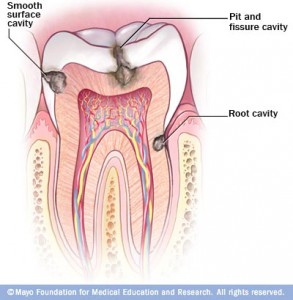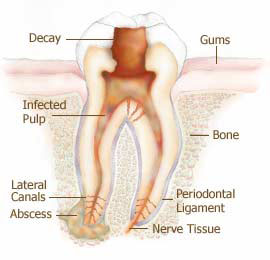Our teeth are constantly being attacked by acid produced by plaque bacteria as well as by the acidic foods and drinks we consumed. Acids cause damage below the tooth surface, causing microscopic holes in the tooth. If the acid damage continues over a period of time, the tooth becomes so fragile that a hole or pitting becomes visible in the tooth. As the hole gets bigger, the tooth will need a filling.
What is a dental cavity filling?
A professionally placed dental restorative material on a tooth which has lost its original structure due to decay or trauma constitutes a dental filling. It is used to restore the function, integrity and aesthetics of the missing tooth structure.
Placement of cavity fillings may take time depending on the amount of tooth structure that needs to be replaced. It usually involves removal of additional tooth structure by drilling during tooth preparation to improve the aesthetics or the support of the intended restorative material. Sometimes injections may be required if the dental cavity or trauma runs deep.
How to determine if a filling is needed
Dentists spend much time treating the ravages of cavities but performing dental fillings is only part of management of cavities. The preventive part is even more important therefore individuals must not regard ‘fillings’ as essential items in their ‘care package’.
When fillings are required as a preliminary approach to prevention
- Patients presenting with pulpal (nerve) pain need stabilization
- Patients with severe discomfort, for example sharp edges of teeth
- Patients with severe aesthetic-related dental problems
- Patients with severe function-related dental problems
It is should emphasized that once stabilization is completed, prevention measures will begin with guidance from your dental professional.
Why the need for a tooth filling?
- The most important reason is to aid plaque control by filling cavity.
- Failure of dentine protection gives sensitivity to hot, cold and sweet substances.
- The pulp is endangered with pulp cells dying.
- Previous attempts to arrest the cavities have failed and there is evidence that the lesion is progressing.
- Functions are impaired
- Drifting is likely to occur through loss of contact point
- For aesthetic purposes, quality of life and general well-being reasons, for example the tooth decay is unsightly
What forms of dental treatment should be undertaken?
Early pit and fissure cavities might be managed by dental sealants whereby a resin coat is attached after tooth enamel acid etching technique. The technique can be categorized as minimally- invasive.
Cavities on the chewing surfaces of teeth need invasive treatment and restorations as they prevent effective plaque control.
Cavities on free smooth surfaces are often easily reached. They can often be remineralized by skillful tooth brushing. However undermined enamel may be removed by dentist. The remineralization process may take months and the use of fluoride toothpaste. Management if the above fails involves restorations.
What happens if you have deep cavities?
Your dentist will make several assessments:
- To see whether the tooth restorable and is restoration preferable to extractions
- To see whether the tooth is symptomless and if not the character and duration of the pain
- Testing vitality of the tooth
- Taking radiographs to check extent of cavity and if there is any pathology at the root tip of the tooth
Management depends upon the condition of the tooth pulp
- Irreversible pulpitis (inflammation of the pulp) or dead pulp – require root canal therapy or extraction
- Reversible pulpitis or healthy pulp – aim to maintain pulp vitality by selective removal of decayed dentine without pulp exposure.
- If traumatic, small and uncontaminated pulp exposure is seen, direct pulp cap is done and tooth is restored
- If cavity exposure and continued pulp vitality is doubtful, root canal therapy will be required.
Secondary cavities
Unfortunately, placement of fillings does not confer cavity immunity upon a tooth. When tooth decay occurs adjacent to a restoration it is called secondary or recurrent cavities. Secondary cavity is difficult to diagnose, but careful observation (clinically and radiographically) rather than intervention is now advocated.
Are fillings really necessary?
Tooth decay prevention can be done through four pillars, which are toothbrushing, dietary advice, fluoride and fissure sealants. This may require:
- Changes in eating and brushing habits.
- Limiting sugar and refined carbohydrates products in your food and drinks
- Effective brushing with fluoride toothpaste morning and night
- Cutting down on sweet snacks and sweetened drinks especially before bedtime
If decay is beginning to develop, placement of sealants over the back teeth that are still healthy may be suggested to protect them from acid attack and reduce the need for fillings at a later date. Once a tooth has a filling, it is not as strong as an unfilled tooth and it will have a greater risk of developing further decay.
Make it a habit to visit your dental professional at least every six months so that your dental professional will be able to help you keep your teeth free of fillings and  ensure that you have healthy teeth throughout your life



